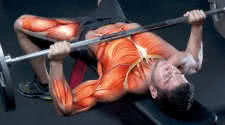Bench Press Exercise

The Proper Exercise Executions for Success
Kinesiological Analysis
The bench press is the most abused weight-training exercise. Bodybuilders are usually so concerned with the weight they handle that they completely ignore their form. Most trainees will do anything to improve their one-rep max (1RM), including arching their backs and bouncing the bar. You can't maximize the tension in your pectoral muscles by using poor technique, which usually places stress only on other muscles and bones. You'll simply increase your risk of injury and minimize your gains.Imagine yourself as a sturdy tripod-contract your abdominals and focus your eyes on one point on the ceiling. Guide the bar smoothly and pause deliberately at both ends of the movement, If you're strict with your technique, you'll maximize safety as well as strength gains. Also, you can reduce shoulder, elbow and/or wrist stress by 1) varying the width of your grip, 2) using an incline bench or 3) performing machine or dumbbell presses at every other workout.
Performance
» Lie on a bench, make a tripod with your feet and buttocks and stabilize your head.» Keep your feet flat on the floor for support.
» Take a palms-forward grip on the bar, with your hands two to four inches wider than your shoulders on each side.
» Contract your abs and keep your back flat on the bench.
» Inhale as you slowly lower the bar to your midchest - at the bottom of the movement your elbows should be directly beneath the bar with your forearms perpendicular to the floor
» Pause with the bar fairly high on your chest, but avoid sliding it toward your neck.
» Drive the bar to the starting position as you exhale
» Don't overextend your arms at the top of the movement or you risk hyperextending your elbows.
Bench Press Do's and Don'ts
» Do check that your grip is even before each set so the bar is balanced properly.» Do use collars on the bar.
» Do touch your chest with the bar.
» Do perform the bench press twice a week.
» Do perform three to six sets of bench presses per workout.
» Do lift a weight of 80 to 95 percent of your 1 RM for two to five reps to improve your strength.
» Do lift a weight of 70 to 80 percent of your 1 RM for six to 10 reps to increase muscle mass.
» Don't bounce the barbell off your chest.
» Don't arch your back or raise your rear off the bench as you press the bar.
» Don't track the bar with your eyes or you may strain your neck; focus on a point on the ceiling instead.
» When spoiling, don't stand directly over the lifter, as this is distracting.
Warm Up and Warm Down
The pectorals and front shoulder muscles are vulnerable to pulls during heavy bench presses. To prevent muscle strains, use both general and specific warmups. Before you stretch, start out by walking, jogging, stepping or cycling lightly-at about 50 percent of your maximum heart rate-for five to 10 minutes. Follow this with standing or sifting stretches. Next do a specific warmup. Do two sets of high-repetition, low-resistance bench presses. Use 30 to 50 percent of your 1RM and do 15 reps. Rest for five minutes, then start your bench press workout.After you're finished, warm down by doing a light aerobic activity for five to 10 minutes, followed by a stretching movement. This will help minimize the pooling of blood and delayed onset muscle soreness.
Spotting Techniques
One or two spotters are usually used for free-weight bench presses. If you're the only spotter, stand in a crouched position about six inches from the lifter's head. Be close enough to help yet far enough away that you won't distract the lifter. If the bodybuilder wants a lift-off, use an alternate grip to grasp the bar and smoothly guide it to the starting position. Be sure to contract your abdominals and use your hips and thighs to do the work, not your lower back. Don't touch the bar unless it's absolutely necessary.If you're one of two spoilers, stand one to two feet from one side of the bar Before spotting heavier lifts, practice spotting lighter ones so that you learn to synchronize your movements with another spoiler. Clasp your hands, track the bar and squat as the lifter lowers the bar to his or her chest. Sometimes three spotters are used for extremely heavy lifts, with one standing at the lifter's head and the other two on either side of the bar.